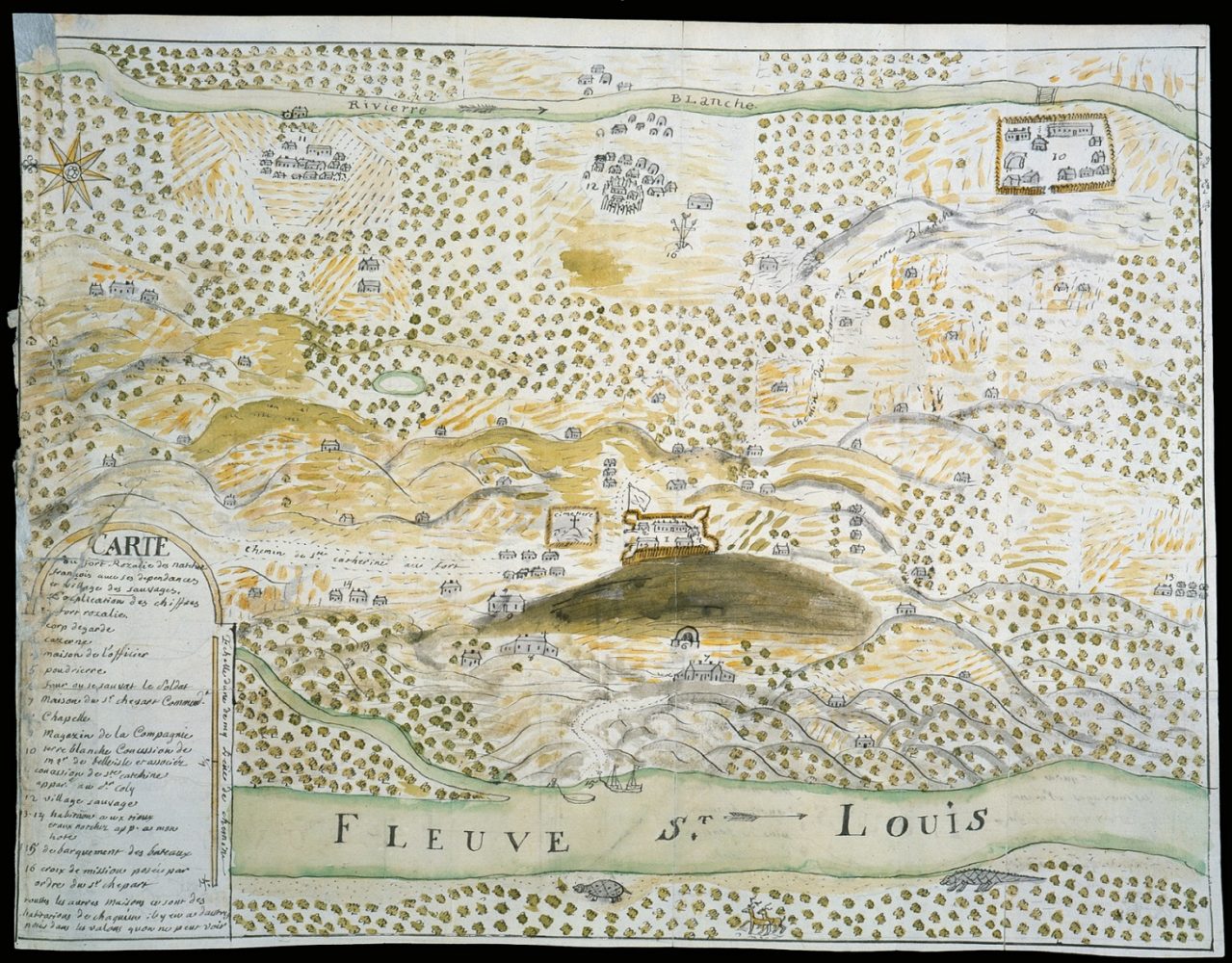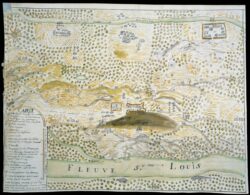Natchez Revolt of 1729
When forced by a French commander to leave their village, Natchez men responded by attacking the French settlement of Fort Rosalie.
This entry is 6th Grade level View Full Entry

Newberry Library
This map from around 1750 depicts the settlement of Natchez and the surrounding area, including Fort Rosalie.
Why did the French establish Fort Rosalie?
At the time of the first French contact with the Natchez Indians in the late seventeenth century, the Natchez lived in at least six villages near the Natchez Bluffs. One estimate puts the population of the Natchez Nation at three thousand in the year 1700. In 1682 René-Robert Cavalier, sieur de La Salle, traveled from Canada down the Mississippi River to its mouth and claimed the river and all its tributaries in the name of France. In the years that followed, French efforts to establish a successful colony led the French government to charter private companies, such as the Company of the West (later the Company of the Indies), to lead settlement and development of the new lands. However, mismanagement and British competition held the fledgling colony back.
It was during this difficult period that a French settlement near present-day Natchez, Mississippi, was founded around 1716. The area was considered attractive for its potential trade opportunities with the Natchez and its high, fertile ground that did not flood and was good for planting crops like tobacco. Just west of the Natchez’s Grand Village, the French built a small fortification enclosed with wooden palisades. They named it Fort Rosalie in honor of the wife of Count Jérôme Pontchartrain, the minister who oversaw France’s colonies under King Louis XIV.
The small settlement slowly grew as the Company of the West and the Company of the Indies issued land grants that allowed French colonists and their enslaved African laborers to clear and farm surrounding lands. By the autumn of 1729 much of the land was used to grow tobacco, and the settlement was home to an estimated 738 non-Indigenous people, including three French officers, 25 French soldiers, 200 male colonists, 80 female colonists, 150 children, and 280 enslaved Africans.
What caused the Natchez uprising?
The 1729 revolt was not spontaneous; it was preceded by small but serious incidents in 1715, 1722, and 1723. In these skirmishes, which often arose from tensions over land and trade, both Frenchmen and Indigenous people were murdered, which caused further retaliation by the opposing party. Relations between the French and Natchez were often strained, and the tension only increased as the settlers went from trading with the Natchez to farming. In 1725 Tattooed Serpent, the Natchez war chief who had worked to preserve peace, died. Then, in 1729, Commander de Chépart, a man considered to be the instigator of the revolt, was put in charge of Fort Rosalie.
Commander de Chépart is remembered as a tyrant who mistreated Natchez and settlers alike. His fatal mistake was demanding that the Natchez immediately relocate from their White Apple Village so that he might establish his own plantation there. He offered no compensation in return. The ultimatum was unimaginable to the Natchez, whose high temple, which held the bones of their royal ancestors, occupied the village, as did residents living in eighty dwellings. The Natchez saw no option but to rid their lands of their aggressors.
A Jesuit missionary recorded the first details of the massacre from the accounts of several survivors who managed to escape and flee downriver to New Orleans:
“First they [the Natchez] divided themselves, and sent into the Fort, into the Village, and into the two grants, as many Savages as there were French in each of these places; then they feigned that they were going out for a grand hunt, and undertook to trade with the French for guns, powder, and ball, offering to pay them as much, even more than was customary and in truth, as there was no reason to suspect their fidelity, they made at that time an exchange of their poultry and corn, for some arms and ammunition which they used advantageously against us. … Having thus posted themselves in different houses, provided with the arms obtained from us, they attacked at the same time each his man, and in less than two hours they massacred more than two hundred of the French.”
How did the uprising effect the development of the Louisiana colony?
Most reports list those killed as 144 men, 35 women, and 56 children. Other French women and children along with enslaved Africans were captured, and a few managed to escape. Speculation continues as to the active role of enslaved Africans and other Indigenous tribes in the revolt. Small skirmishes that resulted in more deaths occurred in the weeks following the massacre.
News of the affair spread fear across the colony, as further violence was expected. As a warning to other Native American groups, colonial Governor Etienne Périer ordered the nearby peaceful Chaouchas slaughtered by the French. A force consisting mostly of Choctaws, who were allies of the French, was sent against the Natchez in February 1730. They managed to free many of the French and African captives before the Natchez slipped away in the dark of night, crossing the Mississippi River and marching through swamps to the Sicily Island area in present-day Catahoula Parish. There the Natchez were able to survive for a year until they were attacked again. Most Natchez then went to the Natchitoches area, where the French captured many of them in the fall of 1731 and sold them into slavery on the Caribbean island of Saint-Domingue. A few survivors took refuge with the British-allied Chickasaws and later the Creeks and Cherokees.
The massacre’s repercussions affected the Louisiana colony for years. Tobacco cultivation was largely abandoned, as were promising agricultural lands in outlying districts. The Company of the Indies, after losing its most promising agricultural settlement, decided to give up its trade monopoly in the colony as a financial disaster. In 1731 the company left Louisiana and returned control of the colony to the French crown.
